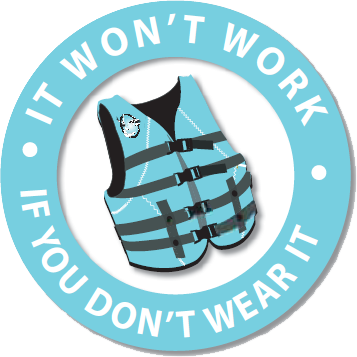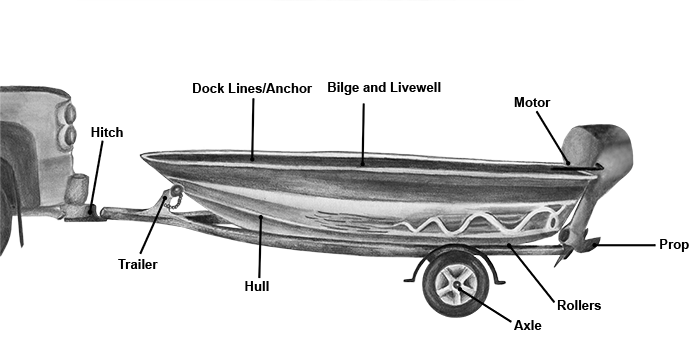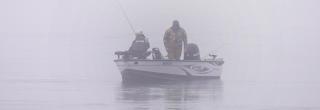
Boating Safety Guide (2023-2025)
Table of Contents
- What Class Are You In?
- Definitions
- Who Must Register Their Boats
- Registration Fees and Renewal Dates
- Change of Address or Ownership
- Loss of Certificate of Number
- Boat Dealers
- Nonresidents
- Attaching the Number to the Boat
- Display of Numbers and Validation Sticker
- Aquatic Nuisance Species Sticker
- Display of ANS Sticker for Out-of-state Boats
- Boat Operator Requirements
- Collisions, Accidents, Casualties and Liability
- Personal Watercraft
- Water-skiing and Surfboards
- Nonmotorized Boats
- Boats for Rent
- Boat Capacity
- Personal Flotation Devices
- U.S. Coast Guard Approved PFDs
- Prohibited Operation
- Regulation of Noise From Boats
- Boating Under Influence
- Termination of Unsafe Use
- Hypothermia
- Diver Flags
- Lighting
- Buoys
- Sanitation Devices
- Regattas, Races, Marine Parades, Tournaments or Exhibitions
- Outboard Motor Serial Numbers
- Boat Motor Restrictions
- Out-of-State Operation
- Aquatic Nuisance Species
Measure Your Boat to Determine What Class Its In
When measuring a vessel, measure from the forward end to the after end across the deck down the center line, excluding the sheer. This means in a straight line and only that part of the hull that is permanent.
All Equipment must be in serviceable condition.
| EQUIPMENT | CLASS A (Under 16 feet in length) |
CLASS 1 (16 feet, but under 26 feet) |
CLASS 2 (26 feet, but under 40 feet) |
CLASS 3 (40 feet or over in length) |
|---|---|---|---|---|
| Registration and Numbering | Every motorboat, principally used in North Dakota, that is powered by any motor (including electric motors) must be registered with the North Dakota Game and Fish Department. | |||
| Personal Flotation Devices (PFDs) (See Page 16 Re: youngsters 10 years and younger.) | One U.S. Coast Guard approved wearable PFD for each person aboard. Anyone being towed on waterskis, surfboard or similar device must wear a USCG approved PFD while being towed (see pages 16-17). No person may operate or permit the operation of a personal watercraft without each person on board the personal watercraft wearing a Coast Guard approved Type, I, II, III or V PFD. | One Coast Guard approved USCG approved PFD for each person aboard, plus one Type IV throwable PFD in each boat. Anyone being towed on waterskis, surfboard or similar device must wear a USCG approved PFD while being towed (see pages 16-17). | One U.S. Coast Guard approved wearable PFD for each person aboard, plus one Type IV throwable PFD in each boat. Anyone being towed on waterskis, surfboard or similar device must wear a USCG approved PFD while being towed (see pages 16-17). | |
| Backfire Flame Arrestors | One Coast Guard approved device is required on each carburetor of all gasoline powered engines, except outboard motors. | |||
| Fire Extinguishers | 1. None required unless the boat has: a. Double bottom not sealed to the hull or not completely filled with flotation material; or b. Closed stowage compartments in which combustible or flammable materials are stored; or c. Closed compartments under thwarts and seats where portable fuel tanks may be stored; or d. Closed living spaces; or e. Permanently installed fuel tanks. If any of the above applies, a Coast Guard approved Type 5-B or 10-B portable extinguisher or a fixed fire extinguishing system in the machinery spaces is required. |
Two Coast Guard approved 5-B or 10-B type portable extinguisher, OR one Coast Guard approved 20-B type portable extinguishers, OR a fixed fire extinguishing system in the machinery spaces and one Coast Guard approved 5-B or 10-B type portable extinguisher. | Either three Coast Guard approved 5-B or 10-B OR one 20-B AND one 5-B or 10-B type portable extinguishers, OR one Coast Guard approved B-II type portable extinguisher and one Coast Guard approved B-I type portable extinguisher, OR a fixed fire extinguishing system in the machinery spaces along with one Coast Guard approved 5-B or 10-B type OR one Coast Guard approved 20-B type portable extinguishers. | |
| Ventilation | All motorboats operating with enclosed engine or fuel compartments and using gasoline as fuel, must have at least two ventilator ducts fitted with cowls, or the equivalent leading to each such compartment to properly and efficiently ventilate the compartment. | |||
| Lighting | All motorboats operating between sunset and sunrise shall exhibit a proper light display. Proper light displays are explained on pages 22-23 of this guide. | |||
| Whistles | One hand, mouth or power operated whistle audible for at least 1/2 mile. | One hand, mouth or power operated whistle audible for at least 1/2 mile. | One hand or power operated whistle audible at least 1 mile. | One power operated whistle audible for at least 1 mile. |
| Bells | None required. | None required. | A bell which produces a clear bell-like tone when struck. | |
Definitions
- “Associated equipment” means:
- Any system, part or component of a boat as originally manufactured, or any similar part or component manufactured or sold for replacement, repair or improvement of such system, part or component;
- Any accessory or equipment for, or appurtenance to, a boat; and
- Any marine safety article, accessory or equipment intended for use by a person on board a boat; but
- Excluding radio equipment.
- “Boat” means any vessel:
- Manufactured or used primarily for noncommercial use;
- Leased, rented or chartered to another for the latter’s noncommercial use; or
- “Manufacturer” means any person engaged in:
- The manufacture, construction or assembly of boats or associated equipment;
- The manufacture or construction of components for boats and associated equipment to be sold for subsequent assembly; and
- The importation into the state for sale of boats, associated equipment or components thereof.
- “Motorboat” means any vessel propelled by machinery, whether or not the machinery is the principal source of propulsion. The term does not include a vessel having a valid marine document issued by the U.S. Bureau of Customs or any federal agency successor thereto.
- “Operate” means to navigate or otherwise use a motorboat or a vessel.
- “Owner” means a person, other than a lienholder, having property in or title to a motorboat. The term includes a person entitled to the use or possession of a motorboat subject to an interest in another person, reserved or created by agreement and securing payment or performance of an obligation, but the term excludes a lessee under a lease not intended as security.
- “Passenger” means every person carried on board a vessel other than:
- The owner or the owner’s representative;
- The operator;
- Bona fide members of the crew engaged in the business of the vessel who have contributed no consideration for their carriage and who are paid for their services; or
- Any guest on board a vessel which is being used exclusively for pleasure purposes who has not contributed any consideration, directly or indirectly, for that person’s carriage.
- “Personal watercraft” means a motorboat that is powered by an inboard motor powering a water jet pump or by an inboard or outboard marine engine and which is designed to be operated by a person sitting, standing or kneeling on the craft, rather than in a conventional manner of sitting or standing inside a motorboat.
- “Slow or no wake speed” means the slowest possible speed necessary to maintain steerage.
- “Undocumented vessel” means a vessel which does not have a valid marine document as a vessel of the United States.
- “Vessel” means any watercraft, other than a seaplane on the water, used or capable of being used as a means of transportation on water.
- “Waters” when not qualified means waters not open to the general public.
- “Waters of the state” means all waters of this state, including boundary waters. This title extends to and is in force and effect over, upon and in all such waters.
Who Must Register Their Boats
Owners of any watercraft propelled by motors must register their vessels with the North Dakota Game and Fish Department. The vessel owner will receive a Watercraft Registration certificate that must be available on the vessel when in operation.
Current boat owners are encouraged to renew their registration online.
Registration of new boats, or transfer of boat ownership, is available online. Anyone buying a new boat from a dealer, or from a private individual, must complete the registration online.
Registration Fees and Renewal Dates
Registration period is from January 1, 2023 through December 31, 2025. Fees are prorated.
MOTORBOATS under 16 feet in length and all canoes regardless of length, powered by a motor – $30.
MOTORBOATS 16 feet in length and over but shorter than 20 feet in length, excluding canoes – $45.
MOTORBOATS 20 feet in length or over, excluding canoes – $60.
The Department is not liable for lost, stolen or damaged stickers. Replacement stickers may be purchased online.
Changes of Address or Ownership
NOTICE: If any of the following instances occur, you are required to notify the Game and Fish Department within 15 days:
- Change of address
- Change of boat ownership
- Boat is destroyed or abandoned
- Boat is stolen or recovered
The Certificate of Number is not transferable. Anyone purchasing a boat must register the boat in their name even if the boat is already registered by the previous owner.
Loss of Certificate of Number
The Game and Fish Department is authorized to issue a new Certificate of Number to replace the one lost. The cost of the replaced Certificate of Number is $10.
Boat Dealers
A dealer may purchase one or more Certificates of Number for demonstrators. The dealer’s number may be transferred from one boat to another for demonstration purposes, but must be securely fastened in such a manner as to be clearly legible.
Nonresidents
North Dakota law permits the use of boats legally numbered under the numbering system of another state for a period of 90 days. Motorboats from foreign countries may temporarily use the waters of North Dakota without a Certificate of Number.
Attaching the Number to the Boat
The number appearing on the Certificate of Number must be painted or permanently attached to each side of the forward half of the vessel near the bow. The number must be in contrasting color to the hull in plain vertical block letters at least 3 inches in height excluding any border, trim, outlining or shading, and must be maintained in a legible condition so that it is clearly visible in daylight hours. The number shall read from left to right, and groups of numbers and letters must be separated by a space or a hyphen equivalent in width to the letter “M.” A validation sticker issued by the Department must be displayed on the boat within 6 inches of the number, toward the rear of the boat. No other numbers are to be displayed in this area.
Display of Numbers and Validation Sticker

Aquatic Nuisance Species Sticker
For motorized watercraft operated on waters in North Dakota and not licensed in North Dakota, state law establishes an ANS fee of $15 to be paid for each calendar year, and to display an ANS sticker on the watercraft..
This ANS sticker must be placed on the starboard side of the watercraft within 6 inches of the registration number and displayed within 10 days of purchase.
Each licensed watercraft is listed on the purchase receipt. A copy of the purchase receipt is proof of validation until the sticker is received via postal mail.
Display of ANS Sticker for Out-of-state Boats
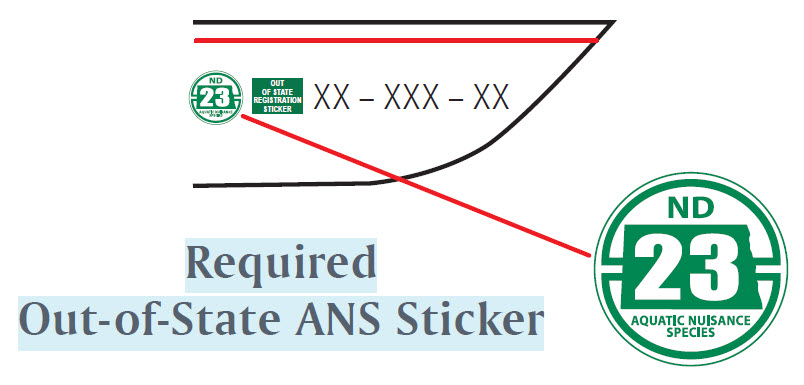
Boat Operator Requirements
No person under 12 years of age may operate a motorboat (includes personal watercraft, i.e., jetskis, etc.) propelled by more than a 10 horsepower motor unless the operator is accompanied by a person 18 years of age or older.
No person 12 through 15 years of age may operate motorboat (includes personal watercraft, i.e., jetskis, etc.) propelled by more than a 10 horsepower motor unless the operator is accompanied by a person 18 years of age or older or the operator has taken and passed a boating course approved by the Department. No person may cause or knowingly permit a minor under 16 years of age to operate a motorboat propelled by more than a 10 horsepower motor unless the minor is otherwise authorized to do so by this section.
Contact the Department for more information on an approved boating course. Some insurance companies give a premium discount to adults who complete an approved boating course.
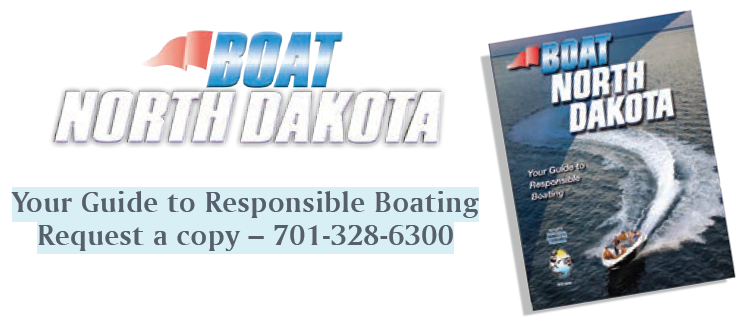
Collisions, Accidents, Casualties, and Liability
The operator/owner of a vessel used for recreational purposes is required to file a report in writing whenever an accident results in: loss of life or disappearance from a vessel; an injury which requires medical treatment beyond first aid; or property damage in excess of $2,000 or complete loss of the vessel. Reports in death and injury cases must be submitted within 48 hours. Reports in other cases must be submitted within five days. Reports must be submitted to the reporting authority in the state where the accident occurred. For more information contact the Department.
Personal Watercraft
No person may operate or permit the operation of a personal watercraft:
- Without each person on board the personal watercraft wearing a U.S. Coast Guard approved type I, II, III or V personal flotation device;
- Within 100 feet of a person fishing from a shoreline, swimmer, swimming/diving raft, or an occupied, anchored, or nonmotorized vessel at greater than slow or no-wake speed;
- While towing an individual on water skis, kneeboard, inflatable craft, or any other device unless an observer on board or the personal watercraft is equipped with a mirror on each side which provides the operator an unobstructed field of vision to the rear;
- Without a lanyard-type engine cutoff switch being attached to the person, clothing or personal flotation device of the operator, if the personal watercraft is equipped by the manufacturer with such a device;
- If any part of the spring-loaded throttle mechanism has been removed, altered or tampered with so as to interfere with the return-to-idle system;
- To chase or harass wildlife;
- Through emergent or floating vegetation at other than slow or no-wake speed;
- In a manner that unreasonably or unnecessarily endangers life, limb or property, including weaving through congested watercraft traffic, jumping the wake ofanother watercraft within 100 feet of the other watercraft; or
- In any other manner that is not reasonable and prudent.
Water-skiing and Surfboards
An individual may not operate a vessel on any waters of this state towing an individual on water skis, surfboard, or similar device unless there is another individual in the towing vessel observing any individual being towed or the vessel is equipped with a mirror at least 78 square inches (198.12 square centimeters) which provides the operator an unobstructed field of vision to the rear. However, this subsection shall not apply to members of any organization regularly staging water ski shows, tournaments or exhibitions while engaged in the performance of such shows, tournaments or exhibitions.
No person may operate a vessel on any waters of this state towing a person or persons on water skis, surfboard or similar device, nor may any person engage in water-skiing, surfboarding or similar activity at any time between the hours from one hour after sunset to one hour before sunrise.
Exemptions are granted to performers engaged in a professional exhibition as authorized under a permit.
No person shall manipulate any water skis, surfboard or similar device without wearing a U.S. Coast Guard approved (persons 16 years of age or older engaged in windsurfing or boardsailing are exempt).
No person may operate or manipulate any vessel, tow rope or other device by which the direction or location of water skis, surfboard or similar device may be affected or controlled in such a way as to cause the water skis, surfboard or similar device, or any person thereon, to collide with or strike against any object or person.
Nonmotorized Boats
Nonmotorized boats (no motor aboard) must have a Coast Guard approved wearable PFD aboard for each person.
Nonmotorized boats operating between sunset and sunrise shall have a readily accessible white light source which shall be temporarily exhibited in sufficient time to prevent a collision, and when at anchor between sunset and sunrise must display a white light visible to a boat approaching from any direction.
Boats for Rent
Owners of boats for hire must comply with the registration and equipment regulations except that the Certificate of Number for vessels less than 26 feet in length, leased or rented for less than 24 hours may be retained on shore at the place of rental, but the rental agreement must be carried in the vessel.
Boat Capacity
No boat may be loaded over capacity. Consult the capacity plate on the boat, if one exists, and do not exceed either the stated maximum weight or the maximum number of people. If there is no capacity plate use the following formula to determine the maximum number of persons you can safely carry in calm weather:
(Length of boat X width)/15 = people.
Personal Flotation Devices (PFDs)
New labels for U.S. Coast Guard Approved PFDs
Wearable PFD - A PFD that is intended to be worn or attached to the body.
Throwable PFD - A PFD that is intended to be thrown to a person in the water.
U.S. Coast Guard Approved PFDs
| Type | Description |
|---|---|
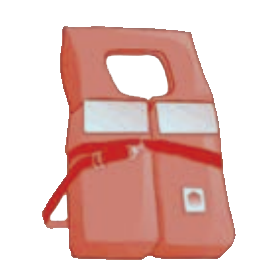 |
A Type I PFD is an approved device designed to turn an unconscious person in the water from a face downward position to a vertical or slightly backward position. |
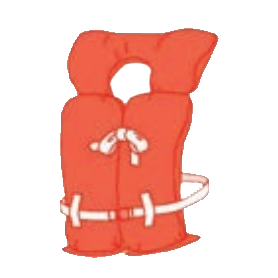 |
A Type II PFD is an approved device designed to turn an unconscious person in the water from a face downward position to a vertical or slightly backward position. |
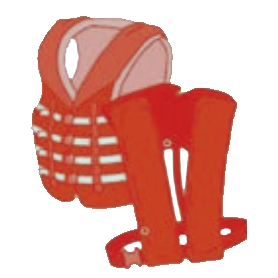 |
A Type III PFD is an approved device designed to keep a conscious person in a vertical or slightly backward position. |
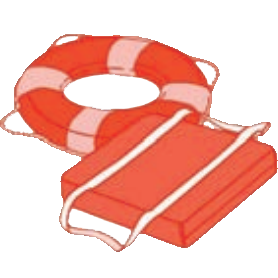 |
A Type IV PFD is an approved device designed to be thrown to a person in the water and not worn. |
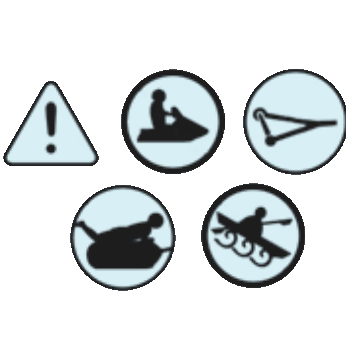 |
SPECIAL USE PFD or A Type V PFD, to be acceptable, must be used in accordance with its label. |
Prohibited Operation
No person may operate any motorboat or vessel, or manipulate any water-skis, surfboard or similar device in a reckless or negligent manner so as to endanger the life, limb or property of any person. Reckless or negligent operation of a motorboat or vessel includes weaving through congested motorboat or vessel traffic, jumping the wake of another motorboat or vessel within 100 feet of the motorboat or vessel, or in any other manner that is not reasonable or prudent.
No person may operate any motorboat or vessel, or manipulate any water-skis, surfboard or similar device while intoxicated or under the influence of any narcotic drug, barbiturate or marijuana.
No person may operate a motorboat or vessel within 100 feet of a person fishing from a shoreline, swimmer, swimming/diving raft, or an occupied, anchored or nonmotorized vessel, or within 250 feet of a reduced speed or slow or no-wake sign at greater than slow or no-wake speed.
For purposes of this provision, reckless or negligent operation includes, but is not limited to the following:
- Use of excessive speed during periods of reduced visibility while in close proximity of other vessels, while in narrow, winding channels, or near docks or marinas.
- Operating in an overloaded condition.
- Operating within swimming areas designated by markers or by the presence of swimmers.
- Operating near dams and other hazardous waters.
- Operating in such a manner as to cause a dangerous or damaging wake.
- Towing water skiers near other vessels or obstructions, into other hazardous areas, or into swimming areas designated by markers or by the presence of swimmers.
- Operation in such a manner as to molest or annoy persons lawfully engaged in fishing.
- Continued use or refusal to terminate use of a boat after being ordered to correct an especially hazardous condition by a law enforcement officer.
Regulation of Noise from Boats
A boat operated on the waters of this state between the hours of midnight and 5 a.m. may not produce a noise in excess of 88 decibels for more than 10 minutes.
The decibel level of a boat must be measured from the shoreline closest to the location from which a complainant or other individual noticed the noise.
Boating Under Influence
Intoxication Testing of Boat Operators
Game wardens or law enforcement officers who have probable cause that a motorboat operator is under the influence of intoxicating liquor, drugs or a combination thereof, may require the operator to take a test to determine his/her sobriety.
The motorboat or vessel must be operated, in motion, en route but not aground or at anchor.
If the operator has an alcohol, drug or combination thereof, concentration of .10 or over, or the operator refuses to submit to testing, his/her operator privileges may be revoked in addition to other penalties.
The law does not prohibit people of legal drinking age from consuming alcoholic beverages or possessing open containers in a boat.
Termination of Unsafe Use
Any law enforcement officer who observes a vessel being used without sufficient lifesaving or fire fighting devices or in an overloaded or other unsafe condition as defined in Department regulations and in his or her judgment such use creates an especially hazardous condition, may direct the operator to take whatever immediate and reasonable steps would be necessary for the safety of those aboard the vessel, including directing the operator to return to mooring and to remain there until the situation creating the hazard is corrected or ended. For the purpose of this provision, an unsafe condition includes, but is not limited to the following:
- Operating without required boat safety equipment.
- Operating in an overloaded condition.
- Fuel leakage or presence of fuel in the bilges.
- Riding on the bow, gunwales, transom, or on the backs of seats without taking precautions sufficient to prevent falls overboard.
- Operating a boat in a state of gross disrepair, rendering it in unseaworthy condition.
- Operating in weather or water conditions which endanger the boat and its occupants.
Hypothermia
Hypothermia, the loss of body heat to the water, is probably the greatest cause of water-related deaths. Often the cause of death is listed as drowning; but, most often the primary cause is hypothermia and the secondary cause is drowning. After an individual has succumbed to hypothermia, he/she will lose consciousness and then drown. The following chart shows the effects of hypothermia:
| Water Temperature (degrees F.) | Exhaustion or Unconsciousness | Expected Time of Survival |
|---|---|---|
| 32.5 | Under 15 minutes | Under 15 to 45 minutes |
| 32.5 to 40 | 15 to 30 minutes | 30 to 90 minutes |
| 40 to 50 | 30 to 60 minutes | 1 to 3 hours |
| 50 to 60 | 1 to 2 hours | 1 to 6 hours |
| 60 to 70 | 2 to 7 hours | 2 to 40 hours |
| 70 to 80 | 3 to 12 hours | 3 hours to indefinitely |
| Over 80 | Indefinitely | Indefinitely |
PFDs can increase survival time because of the insulation they provide. Naturally, the warmer the water, the less insulation one will require. When operating in cold waters (below 40° F) consideration should be given to using a coat or jacket-style PFD as they cover more of the body than the vest-style PFDs.
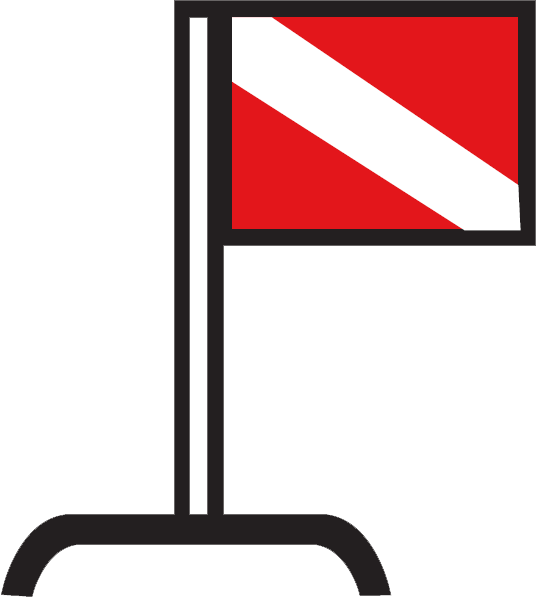
Divers Flag
A diver flag must be displayed on a float or buoy during any diving or spearfishing. Operators of boats must exercise caution when near a diver flag.
Lighting
Lights When Anchored or Operating Nonpowered Boats
Power boats under 65 feet and all sailing vessels at anchor must display anchor lights except in “special anchorage areas.” An anchor light is a white light visible to a boat approaching from any direction, and is displayed in the fore part of the vessel.
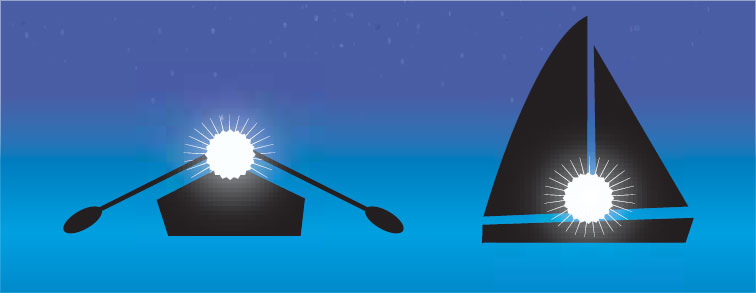
All nonpowered boats operating between sunset and sunrise shall have a readily accessible white light source which shall be temporarily exhibited in sufficient time to prevent a collision.
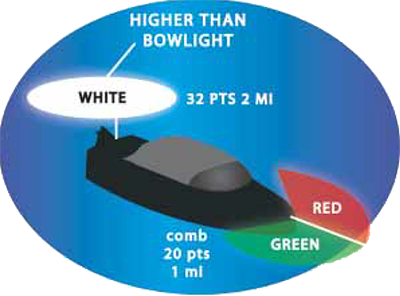
Less Than 26 Feet
Motorboats operating between sunset and sunrise shall exhibit a 20-point (225 degree) combination red and green bow light, visible for one mile, the left side being red, the right side being green, and 32-point (360 degree) white stern light visible for two miles, placed higher than the bow light and unobstructed by occupants or portions of the vessel. In addition, all vessels at anchor between sunset and sunrise must display a white anchor light visible to a boat approaching from any direction.
26 Feet to Not More Than 65 Feet
Motorboats operating between sunset and sunrise shall exhibit a 20-point (225 degree) white bow light visible for two miles, a red 10-point (112 1/2 degree) side light on the left side and a green, 10 point (112 1/2 degree) side light on the right side, both visible for 1 mile (the arc of visibility of the side lights must begin parallel to the center-line of the vessel and extend 10 points toward the stern) and a 32-point (360 degree) white stern light visible for 2 miles, placed higher than the bowlight and unobstructed by occupants or portions of the vessel. In addition all vessels at anchor between sunset and sunrise must display a white anchor light visible to a boat approaching from any direction.

Important: stern lights must be placed high enough that their light will not be blocked by persons or parts of the boat or its equipment.
Buoys
Placement of Regulatory Signs, Markers, Buoys and Other Warning or Marking Devices
Upon written approval of the Game and Fish director, regulatory signs, markers, buoys or other warning or marking devices may be placed near or in the waters of this state as may be necessary for safety or recreation.
Sanitation Devices
If a vessel is equipped with a marine toilet or other similar device for the disposition of sewage or other wastes, only that type of marine toilet equipped with a treatment device meeting standards established by the state water pollution control board. The board shall furnish a list of the types of treatment devices currently available and considered acceptable for use with marine toilets under this subsection. No person owning or operating a vessel upon the waters of this state may use, operate or permit the use or operation of any marine toilet or similar device unless it is approved under this subsection. No person may discharge into the waters of this state, directly or indirectly from a vessel, any untreated sewage or other wastes. No container of untreated sewage or other wastes may be placed, left, discharged or caused to be placed, left, or discharged in or near any waters of this state from a vessel in such a manner or quantity as to create a nuisance or health hazard, or pollute such waters.
No person may operate or give permission for the operation of a vessel which is not equipped as required by this section or modification thereof.
Regattas, Races, Marine Parades, Tournaments, or Exhibitions
The Department may authorize the holding of regattas, motorboat, or other boat races, marine parades, tournaments or exhibitions on any waters of this state. Whenever a regatta, motorboat, or other boat race, marine parade, tournaments or exhibition is proposed to be held, the person in charge thereof, shall, at least 10 days prior thereto, file an application with the Department for permission to hold the same, and it shall not be conducted without authorization of the Department in writing.
Outboard Motor Serial Numbers
No outboard motor manufactured after January 1, 1980, shall be sold or offered for commercial sale by a dealer in this state unless the motor has permanently engraved thereon by the manufacturer an identifying serial number. The serial mark shall be of a permanent nature so as to prevent or discourage the removal, defacing, alteration or destruction thereof.
No person may possess, repair, or sell an outboard motor, acquired after January 1, 1980, from which the serial number has been removed.
Boat Motor Restrictions
Some North Dakota lakes have watercraft restrictions such as “Idle Speed Only” or “Electric Motors Only.” “Idle Speed Only” is defined as operating a boat at the slowest possible speed necessary to maintain steerage (i.e., trolling – with no wake).
Electric Motors Only: (Note: Boats may be propelled manually or with an electric motor. No combustion motor may be operated on these waters): Casselton Reservoir, Davis Dam, Dickinson Dike, Heinrich-Martin Dam, J. Clark Salyer, Kettle Lake, Larimore Dam, Lightning Lake, McDowell Dam, Mooreton Pond, Sather Dam, Spring Lake Park Ponds and Strawberry Lake (Turtle Mountains).
Idle Speed Only: Alkali Lake (Stutsman Co.), Arroda Lakes, Arrowwood Wildlife Refuge, Lake Audubon (north arm), Baukol-Noonan Dam, Baukol-Noonan East Mine Pond, Belfield Pond, Boundary Lake, Brewer Lake, Camels Hump Dam, Carbury Dam, Clausen Springs Lake, Coal Mine Lake, Crown Butte, Davis WPA, Dion Lake, Epping-Springbrook Dam, Fish Creek Dam, Fordville Dam, Gravel Lake, Harmon Lake, Harmony Lake, Heart Butte (Lake Tschida) – designated areas only, Hooker Lake, Lake Ilo, Indian Creek Dam, Jensen Lake, Jim Lake Wildlife Refuge, Kota-Ray Dam, Kraft Slough, Long Lake Wildlife Refuge, McClusky Canal proper, McGregor Dam, Mirror Lake, North Golden Lake, Pelican Lake, Raleigh Reservoir, Sheep Creek Dam, South Carlson Lake, Sweet Briar Dam, and along the Missouri River at the mouths of the Heart River, Lakewood, Marina Bay, Misty Waters and Square Butte Creek.
Out of State Operation
Boating laws and regulations vary from state to state. If planning on taking your boat to another state, determine what the boating and trailer regulations are in the state where you plan on boating, and prepare yourself, boat, and trailer to abide by them, and avoid a costly fine or delay.
Aquatic Nuisance Species
Aquatic nuisance species are nonnative plants and animals that threaten our lakes and streams. They are very difficult to control once they become established, and can be moved accidentally on boats, trailers and other equipment.
Three simple steps can prevent the spread of ANS:
- Clean – Inspect all equipment and remove any plants, animals, and mud before leaving a water access site.
- Drain – Allow all water to drain completely before leaving the water access site.
- Dry – Allow all equipment to dry completely or wash with hot water (140°F) before using again.
Places to Check:
Learn more about ANS in North Dakota, including regulations.

